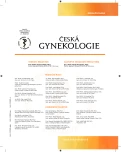-
Medical journals
- Career
The influence of warmed infusion during C-section on the mother and child – a pilot randomised prospective study
Authors: M. Kirchnerová 1; Z. Mrozek 1; I. Oborná 2; L. Kantor 3
Authors‘ workplace: Klinika anesteziologie, resuscitace a intenzivní medicíny LF UP a FN, Olomouc, přednosta doc. MUDr. M. Adamus, Ph. D. 1; Klinika porodnictví a gynekologie LF UP a FN, Olomouc, přednosta prof. MUDr. R. Pilka, Ph. D. 2; Novorozenecké oddělení FN, Olomouc 3
Published in: Ceska Gynekol 2013; 78(3): 237-242
Overview
Aim of the study:
To evaluate the influence of warmed infusions on the mother’s and newborn’s well-being after C-section.Design:
Prospective randomized study.Setting:
Dept. of Anaesthesiology, Resuscitation and Intensive Care Medicine, Dept. of Obstetrics and Gynaecology, Faculty of Medicine and Dentistry Palacký University and University Hospital Olomouc.Methods:
Prospective randomized study including 29 pregnant women between 38th and 42nd week of pregnancy, that were indicated to elective caesarian section (SC) and from all of which the fetal distress was excluded. The women were randomized into four groups according to the temperature of applied infusion solution – colloids and afterwards crystalloids (pre-heated and non pre-heated), and according to the type of anaesthesia (general or SAB). These values were monitored in perioperative period: body temperature, differences of hemoglobin and hematocrit levels, tremor and pain level after the operation. In newborns the acid-base balance parameters and Apgar score were monitored.Results:
The study is still going on, however up to now some of the results suggest that usage of pre-heated infusion solutions is effective both for mother and child in increasing of their comfort in the perioperative period. In the group of actively heated mothers we have noticed: lower perioperative blood loss – differences in haemoglobin levels were 8 g/l compared to 15 g/l in the group of non heated mothers. The umbilical cord blood of the newborns whose mothers were not actively heated and were operated in subarachnoid anaesthesia had the lowest pO2 (0.9 kPa). The lowest level of umbilical cord blood lactate was noticed in the group of newborns whose mothers underwent the surgery under general anaesthesia and were actively heated.Conclusion:
Up to now results suggest that the heating of mothers during the SC lowers the loss of body temperature, blood loss, and perception of pain by the mother. In combination with general anaesthesia it increases pO2 and lowers the levels of lactate in umbilical arteria in the newborns.Keywords:
section – warmed infusion – body temperature
Sources
1. Algert, CS., et al. Regional block versus general anaesthesia for Caesarean section and neonatal outcomes. BMC Medicine, 2009, (http://www.biomedcentral.com/1741-7015/7/20).
2. Davies, P., French, GWG. A randomised trial comparing 5 ml/kgand 10 ml/kg of pentastarch as a volume preload before spinal anaesthesia for elective caesarean section. Inter J Obstet Anesth, 2006, 15, p. 279–283.
3. Jabor, A., a kol. Vnitřní prostředí. Praha: Grada, 2008.
4. Chung, SH., Lee, BS., Yang, HJ., et al. Effect of preoperative warming during cesarean section under spinal anesthesia. Korean J Anesthesiol, 2012, 62, p. 45–460.
5. Horn, EP., Schroeder, F., Gottschalk, A., Sessler, D. Active warming during Cesarean delivery. Anesth Analg, 2002, 94, p. 409–414.
6. Larsen, R. Anestezie. Praha: Grada, 2004, s. 959–960.
7. Lee, SH., Kim, HK., Park, S., et al. The effect of infusion rate and catheter length on the temperature of warming fluids. KoreanJ Anestesiol, 2010, 58, p. 31–37.
8. Moola, S., Lockwood, C. Effectiveness of strategies for the management and/or prevention of hypotermia within the adult perioperative environment. Inter J Evidence – Based Healthcare, 2011, 4, p. 337–345.
9. Pařízek, A. Spinální anestezie u císařského řezu. Anesteziologie & intenzivní medicína, 2006, 17, s. 274–276.
10. Pařízek, A., a kol. Porodnická analgezie a anestezie. Praha: Grada, 2002, s. 327.
11. Reynolds, F., et al. Anaesthesia for Caesarean section and neonatal acid-base status: a metaanalysis. Anaesthesia, 2005, p. 636–653.
12. Woolnough, M., Allam, J., Hemingway, C., et al. Intra-operativ fluid warming in elective caesarean section: a blinded randomised controlled trial. Int J Obstet Anesth, 2009, 18, p. 346–351.
13. Yokoyama, K., Shimada, Y., Matsushima, T., et al. Effect of administration of pre-warmed intravenous fluids on the frequency of hypotermia following spinal anesthesia for Cesarean delivery. J Clin Anesth, 2009, 21, p. 242–248.
Labels
Paediatric gynaecology Gynaecology and obstetrics Reproduction medicine
Article was published inCzech Gynaecology

2013 Issue 3-
All articles in this issue
- Peripartum cardiomyopathy after caesarean section – a case report
- Endothelial dysfunction in pregnancies with chronic hypertension
- The influence of warmed infusion during C-section on the mother and child – a pilot randomised prospective study
- Gynaecological surgery of Jehovah´s Witnesses
- The incidence of latent asymptomatic celiac disease in women with decreased fertility
- Persistence of the treatment of overactive bladderin Czech Republic
- Radiotherapy in vulvar cancer treatment
- Expression of carbonic anhydrase IX in the breast carcinomas
-
Psychosocial climate in maternity hospitals from the perspective of parturients II.
Predictors of women‘s satisfaction with perinatal care in the Czech Republic - Intrahepatic cholestasis of pregnancy
- Determination of anti-Müllerian hormone in women
- Cervical cancer – possibilities of detection of human papillomavirus
- Antibiotic profylaxis in obstetrics
- Solitary fibrous tumor of endometrium – a case report
- Czech Gynaecology
- Journal archive
- Current issue
- Online only
- About the journal
Most read in this issue- Intrahepatic cholestasis of pregnancy
- Determination of anti-Müllerian hormone in women
- Antibiotic profylaxis in obstetrics
- Peripartum cardiomyopathy after caesarean section – a case report
Login#ADS_BOTTOM_SCRIPTS#Forgotten passwordEnter the email address that you registered with. We will send you instructions on how to set a new password.
- Career

